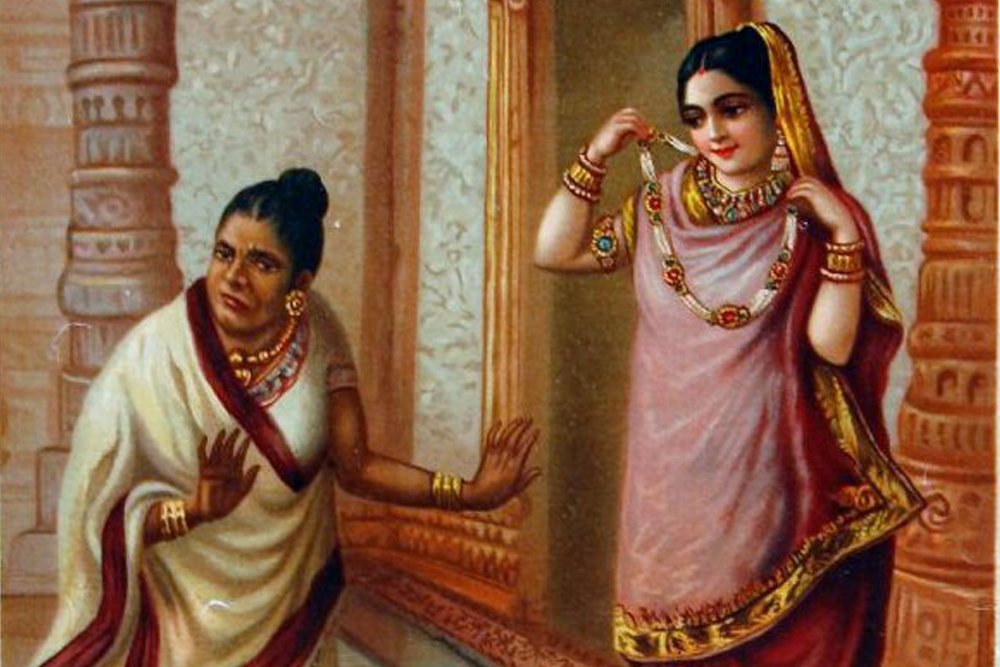Introduction
Kaikeyi is a name many people know from the Ramayana. She is one of King Dasharatha’s three queens. Her story touches on power, fear, love, and regret. In simple words, Kaikeyi shaped a key turning point in the epic. Her actions led to Prince Rama’s exile and changed the fate of Ayodhya. This article will tell Kaikeyi’s story in a clear, friendly way. You will find history, meaning, and modern lessons. I will explain why people have mixed feelings about her. I will share examples that make her human and real. Read on to learn not just what she did, but why she might have acted that way. This view aims to be fair and helpful.
Who was Kaikeyi?
Kaikeyi was a queen of Ayodhya. She was one of King Dasharatha’s wives. She was the mother of Prince Bharata. In many versions she is described as brave and strong. Some tell her as proud and fearful. The name Kaikeyi links her to the kingdom of Kekaya. That kingdom is far from Ayodhya. She grew up with royal duties and training. As queen she had voice and power at court. People often judge her for asking for Rama’s exile. But she also had stories showing loyalty and care. Looking at her whole life gives a deeper picture. That helps us see her as more than a villain.
Kaikeyi in the Ramayana: the key scene
The most famous moment in Kaikeyi’s life is in the coronation scene. King Dasharatha wants Rama to be king. Rama is loved for his goodness and strength. Kaikeyi hears this and grows afraid for her son Bharata. Her maid Manthara fans that fear. Manthara reminds Kaikeyi of old promises. Kaikeyi then asks Dasharatha for two boons. She uses those boons to make Rama go to exile for fourteen years. She also asks that Bharata become king. That choice changes everything. Rama accepts exile with calm and duty. The scene is dramatic and full of sorrow. Many storytellers show Kaikeyi grieving later for what she caused.
Kaikeyi’s early life and place in Ayodhya
Kaikeyi came from the land of Kekaya. Her background shaped her choices later. As a princess she learned court manners and politics. She married Dasharatha and moved to Ayodhya. There she lived among other queens and royal children. Life at court could be tense and jealous. Rivalries and alliances mattered. A queen needed skill to protect her child’s future. This view helps explain Kaikeyi’s fear for Bharata. Her choices were not only personal. They were shaped by royal duty and the court’s expectations. Understanding her upbringing gives context to her later actions. It also shows how hard life could be for women at court.
The boons and the turning point
Years earlier Dasharatha saved Kaikeyi in battle. He promised her two boons to be used later. Those boons could change destiny. When the moment came, Kaikeyi remembered the promise. She feared losing power and her son’s future. So she asked for the boons then. Using a boon for exile is a heavy choice. It shows how promises in royal life held real weight. Many readers ask why Kaikeyi asked for exile. Some say she was jealous. Others say she acted out of duty to her child. The boons scene forces us to ask hard questions. It also shows how a single choice can alter many lives.
Kaikeyi and Manthara: friendship and influence
Manthara is the maid who advised Kaikeyi. In many retellings Manthara stoked Kaikeyi’s fear. She painted Rama as a threat to Kaikeyi’s place. This influence is central to the story. It raises the issue of counsel and free will. Was Kaikeyi fully responsible, or did she act under pressure? Ancient stories like the Ramayana often show such human dynamics. A trusted voice can lead a person toward harm or good. In Kaikeyi’s case Manthara’s words had great power. This part reminds us to think about who we trust in hard moments. It also shows how gossip and fear spread inside a palace.
Political and emotional motives behind Kaikeyi’s choice
Kaikeyi’s act mixed politics and emotion. On one hand she wanted Bharata’s future secured. On the other hand she feared losing status. Royal life often meant competition for the throne. Mothers had to protect their sons. Emotion can cloud judgment in such times. Kaikeyi may have acted from love and from fear. She may also have felt betrayed by the crowd’s praise for Rama. That crowd reaction could hurt a mother’s pride. Seeing these motives makes her actions more human. It does not excuse harm. But it helps us understand why such harm happened. Understanding motives adds balance to our judgment.
Kaikeyi’s relationship with Rama and Bharata
Kaikeyi raised Bharata with care and hope. Her relationship with Rama was complex. Rama treated his stepmother with respect. He showed love to all his parents. After Rama’s exile, Bharata hated Kaikeyi’s decision. He refused to become king. Instead he placed Rama’s sandals on the throne. Bharata ruled only as Rama’s regent. This act showed his deep loyalty. Kaikeyi later faced isolation and shame. She watched Bharata’s love for Rama and felt the cost of her decision. Their family pain is a key part of the Ramayana’s emotional power. It teaches about duty, forgiveness, and sacrifice.
How later retellings reinterpret Kaikeyi
Many later poets and writers retold Kaikeyi’s story. Some made her a villain. Others gave her a kinder light. Feminist retellings often explore her fear and agency. Regional versions change details and motives. For example, some versions show Kaikeyi as misguided but repentant. Others show her as politically savvy and bold. These retellings help us see how culture shapes a character. They also let each generation ask new questions. Was Kaikeyi wicked or only human? Writers use her to talk about motherhood, power, and ethics. This variety keeps Kaikeyi alive in art and thought.
Lessons from Kaikeyi for modern life
Kaikeyi’s story still speaks to us today. It teaches about promises, influence, and regret. It shows how fear can lead to harsh choices. It warns about using power for personal ends. At the same time it shows the cost of blind praise. Modern leaders and families can learn from Kaikeyi. We should check who advises us. We should weigh short gains against long harm. We should teach children to balance duty and love. Real life has messy choices like Kaikeyi’s. Her tale can help people practice empathy and better judgment.
Kaikeyi in art, drama, and popular culture
Kaikeyi appears in many plays and movies. Artists paint her moments of grief and anger. Dance forms like Kathakali and Bharatanatyam stage her scenes. Modern films and web shows also retell her role. Each performance brings new nuance. Creators may soften her image or make her stern. This variety keeps audiences thinking. Street theatre and folk songs also tell her story. These arts show how Kaikeyi’s tale resonates across time and place. They help people feel the pain and drama more deeply. Art invites viewers to see Kaikeyi as a layered human being.
Common misconceptions about Kaikeyi
People often reduce Kaikeyi to a single act. They call her cruel and stop there. This is a common mistake. The Ramayana shows many sides of her life. She had duties, fears, and loyalties. Another myth says she was purely evil. That view ignores context and motive. Some modern readers also blame Manthara alone. Yet Kaikeyi made her own choice. A balanced view sees fault and complexity at once. It helps us avoid simplistic thinking. Clearing misconceptions lets the story teach more useful lessons about people and power.
How to read Kaikeyi with empathy
Reading Kaikeyi with empathy does not excuse harm. It asks us to see why she acted. Empathy helps us learn and prevent repeats of harm. We can imagine what it means to live under court pressure. We can feel her fear for Bharata. This stance also helps in modern conflicts. When we study a person’s motives, we can act more fairly. Empathy asks us to balance judgment and understanding. It allows space for apology and repair. In many versions Kaikeyi seeks forgiveness later. That part invites readers to consider grace and change.
Kaikeyi and the theme of dharma
Dharma is a central idea in the Ramayana. It means duty, right action, and moral order. Kaikeyi’s choice raises hard dharma questions. Was she protecting her child’s dharma? Or did she break social dharma by causing harm? Rama’s exile is often seen as his adherence to dharma. Kaikeyi’s act tests many characters’ sense of duty. The epic thus teaches about the tension between personal duty and public good. This tension still appears in modern law and ethics. Thinking about Kaikeyi helps readers explore what duty means in life and leadership.
Kaikeyi in comparative myth and global view
Kaikeyi’s story is not the only one about a queen’s hard choice. Many cultures have tales of parents choosing power over kin. Comparing them shows shared human themes. Stories from world myth often explore jealousy, exile, and promises. Kaikeyi fits this global pattern of moral testing. This view helps readers see the Ramayana as both local and universal. It also helps teachers use Kaikeyi in cross-cultural lessons. When students compare myths, they find common human fears and hopes.
Personal insights and modern examples
I have taught parts of the Ramayana in simple classes. Students often ask why Kaikeyi acted as she did. We talk about pressure, fear, and the power of trusted voices. One student linked Kaikeyi to a real story at school. A club leader promised a role and later used it to demand favors. The parallels were clear. These small modern examples show how promises and influence work. They make Kaikeyi relatable and instructive. Sharing these examples helps readers see the epic as living and practical.
Spiritual and psychological readings of Kaikeyi
Some readers see Kaikeyi through psychology. Fear, attachment, and ego shape her choice. Psychologists might call this a fear-driven decision. Spiritual readers see her as part of a larger moral test. Both views add depth. They let us learn both practical and inner lessons. A psychological view suggests tools for change, like self-reflection. A spiritual view invites forgiveness and growth. Together they offer a fuller response to Kaikeyi’s life. They can help individuals heal from harm and make better choices.
Teaching Kaikeyi to children
Explaining Kaikeyi to children needs care and simplicity. Start with clear facts and short stories. Focus on choices and consequences. Ask simple questions like, “Why did Kaikeyi worry?” Use role play to show emotions. Emphasize lessons about honesty and courage. Avoid harsh labels like “bad” or “evil.” Help children see the human side of Kaikeyi. This approach builds empathy and moral thinking. It also keeps the story age-appropriate and meaningful.
Kaikeyi and gender perspectives
Gender studies often examine Kaikeyi’s story. Some argue her portrayal reflects patriarchal fears. A queen who acted politically might face harsher judgment. Others see her as a powerful woman who used authority. Feminist readings explore how female power is shown in epic tales. These studies offer new insights. They ask how society shapes judgments of women in power. They also open doors to reimagining Kaikeyi in modern stories. This lens helps readers think about gender, voice, and fairness.
Common interpretations in regional traditions
Across India and beyond, regional retellings of Kaikeyi vary. In some areas she is shown more sympathetically. In others she is stern and unrepentant. Folk tales and local plays often adapt the story to local morals. These variations highlight cultural diversity. They also show how living traditions keep the Ramayana fresh. Scholars study these versions to learn more about history and belief. For readers, regional tales offer many ways to connect with Kaikeyi’s life.
FAQs
Q1: Was Kaikeyi evil?
No single label like “evil” fits Kaikeyi well. She acted from fear and duty. She also used power that she rightfully held. The Ramayana shows her regret later in many versions. Seeing her whole life gives a fairer view. Labeling her only as evil removes chance for learning. It hides the human reasons behind her choice. A balanced read shows both responsibility and context. That view helps us learn about influence and repair.
Q2: Why did Kaikeyi ask for Rama’s exile?
Kaikeyi asked because she feared losing her son’s chance at the throne. She also remembered Dasharatha’s boons. Manthara’s influence amplified these fears. Royal politics added pressure and urgency. Her choice mixed personal love and political instinct. It was a complex reaction, not a simple plot to harm Rama. Understanding these layers helps explain why she made that request.
Q3: Did Kaikeyi regret her decision?
Many versions show Kaikeyi regretting what she did. She sees the pain caused to Rama and others. Her regret is a central human element of the story. It shows that people can change and learn. Regret does not erase harm. But it opens space for apology and healing. That part of her story invites readers to consider forgiveness.
Q4: How do modern writers treat Kaikeyi?
Modern writers often explore her motives and pain. Some retellings make her sympathetic. Others examine the court politics that shaped her. Feminist authors question how history judged her. Filmmakers and playwrights use her to talk about power and motherly love. The modern angle often tries to give her a voice and backstory.
Q5: Is Kaikeyi the same in all Ramayana versions?
No. Different regions and poets change details. The broad plot of boons and exile stays. But motives, tone, and aftermath vary. Some versions soften her image. Others make her actions harsher. This diversity enriches the epic and our view of Kaikeyi.
Q6: What can leaders learn from Kaikeyi?
Leaders can learn about influence, counsel, and long-term thinking. They should be wary of fear-based decisions. Good leaders check motives and seek wise counsel. They also weigh personal loyalty against the common good. Kaikeyi’s tale is a useful case study in power and responsibility.
Conclusion
Kaikeyi is a complex and human figure from the Ramayana. Her story teaches about promises, fear, counsel, and regret. She was a mother, a queen, and a person who made a fateful choice. Seeing her whole life gives more justice than simple blame. Her tale still helps leaders, parents, and readers today. It asks us to think about duty and empathy. It shows that a single choice can shape many lives. If you read Kaikeyi’s story with care, you gain lessons for both heart and mind. I invite you to reflect on her motives and to share your thoughts or questions below.









